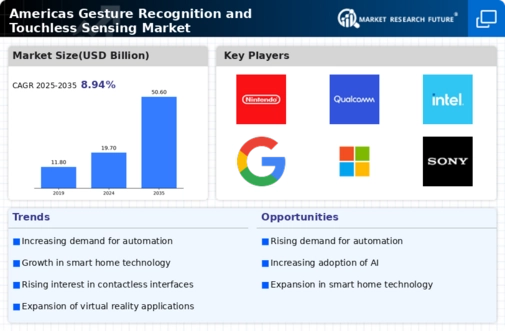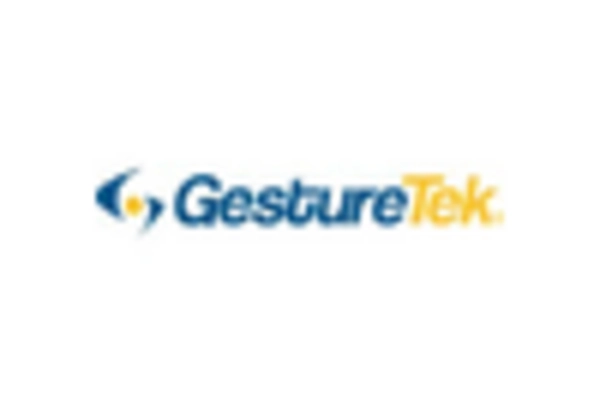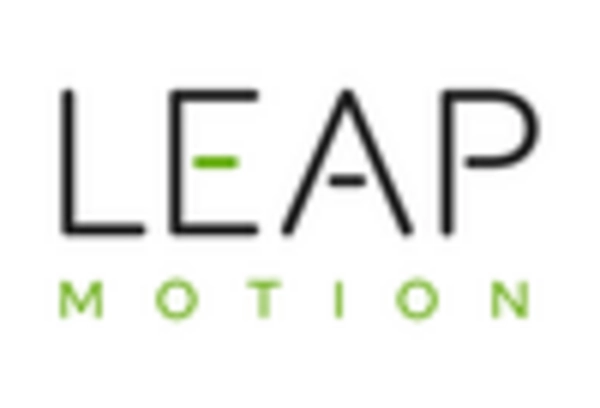Rising Demand for Contactless Solutions
The gesture recognition-touchless-sensing market is witnessing a surge in demand for contactless solutions, particularly in public spaces and commercial environments. This trend is driven by a growing awareness of hygiene and safety, prompting businesses to seek alternatives to traditional interfaces. For example, touchless kiosks and interactive displays are becoming commonplace in retail and hospitality sectors, allowing customers to engage without physical contact. According to market analysis, the North American segment is expected to account for over 40% of the total market share by 2026, reflecting a significant shift towards touchless technology. This demand is likely to encourage further innovation and investment in gesture recognition systems, as companies strive to meet consumer expectations for safety and convenience.
Enhanced User Experience and Accessibility
The gesture recognition-touchless-sensing market is increasingly focused on enhancing user experience and accessibility. Gesture recognition systems offer intuitive interfaces that can be particularly beneficial for individuals with disabilities, providing them with alternative means of interaction. This focus on inclusivity is driving demand for touchless solutions in various applications, including public transportation and smart environments. In North America, the market is expected to grow by approximately 20% annually as organizations prioritize accessibility in their technology offerings. By improving user experience through gesture recognition, companies can not only meet regulatory requirements but also expand their customer base, making this a key driver for growth in the industry.
Increased Investment in Smart Technologies
The gesture recognition-touchless-sensing market is benefiting from increased investment in smart technologies across various sectors. Companies are recognizing the potential of gesture recognition systems to enhance user experiences and streamline operations. For instance, the integration of touchless interfaces in smart home devices is gaining traction, allowing users to control appliances with simple gestures. The North American market is projected to see investments exceeding $2 billion by 2027, as businesses aim to leverage these technologies for competitive advantage. This influx of capital is likely to accelerate the development of innovative solutions, further propelling the growth of the gesture recognition market. As smart technologies continue to evolve, the demand for intuitive and seamless user interactions is expected to rise.
Growing Applications in Retail and Advertising
The gesture recognition-touchless-sensing market is expanding its footprint in retail and advertising, where interactive displays and touchless interfaces are becoming increasingly prevalent. Retailers are adopting gesture recognition systems to create engaging shopping experiences, allowing customers to browse products and access information without physical contact. This trend is supported by data indicating that interactive displays can increase customer engagement by up to 70%. In North America, the retail sector is anticipated to invest heavily in these technologies, with projections suggesting a market growth of approximately 30% by 2028. As businesses seek to differentiate themselves in a competitive landscape, the adoption of gesture recognition systems is likely to play a crucial role in enhancing customer interactions and driving sales.
Technological Advancements in Sensing Technologies
The gesture recognition-touchless-sensing market is experiencing rapid technological advancements, particularly in sensor technologies. Innovations such as infrared sensors, ultrasonic sensors, and computer vision are enhancing the accuracy and responsiveness of gesture recognition systems. These advancements are likely to drive market growth, as they enable more sophisticated applications across various sectors. For instance, the integration of machine learning algorithms is improving the ability of systems to interpret complex gestures, thereby expanding their usability. The North American market is projected to witness a compound annual growth rate (CAGR) of approximately 25% from 2025 to 2030, driven by these technological improvements. As companies invest in research and development, the potential for new applications in areas such as retail and entertainment is becoming increasingly apparent.

















Leave a Comment